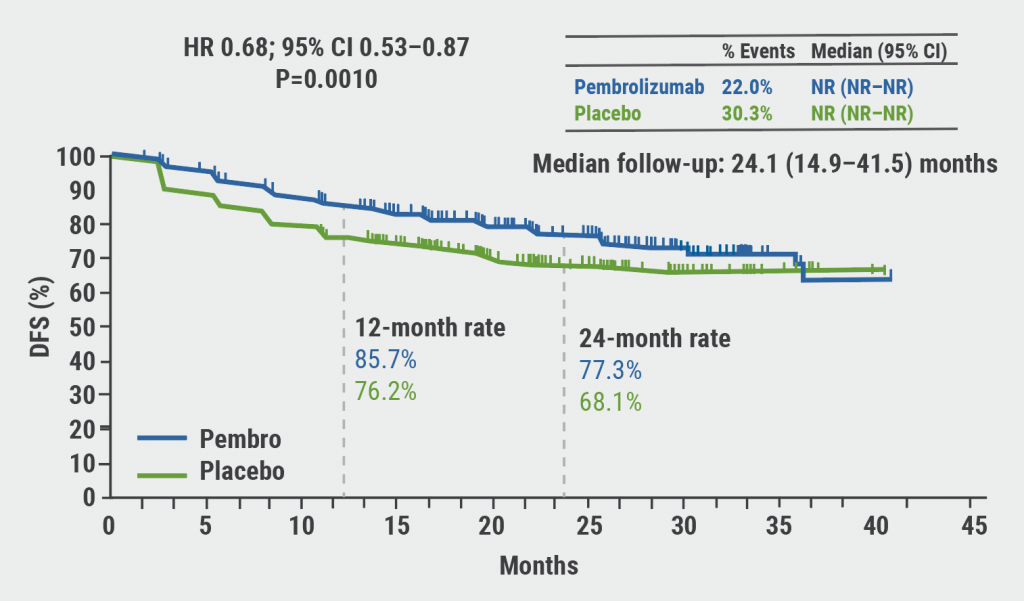A randomised-controlled, phase 3 trial (NCT04753697) tested the IL-13 inhibitor cendakimab against a placebo in a large population of patients with EoE (n=430) between 12 and 75 years of age [1]. Participants were allocated to a weekly dose of cendakimab 360 mg subcutaneously (n=286) or a placebo (n=144). The co-primary endpoints were the mean change from baseline to week 24 in dysphagia days, using the modified daily symptom diary, and the proportion of patients with a histologic response (peak eosinophil count ≤6/high power field) at week 24. Dr Alain Schoepfer (University of Lausanne, Switzerland) presented the key findings.
For the first primary endpoint, the least square mean changes were -6.1 days for the intervention arm and -4.2 days for the placebo arm (delta -1.9; 95% CI -3.0 to -0.8; P=0.0005). The other primary endpoint also significantly favoured the cendakimab arm over the placebo arm (28.6% vs 2.2%; delta 26.4%; 95% CI 20.6–32.2; P<0.0001). “Cendakimab was superior to placebo in terms of endoscopic response and other key secondary endpoints as well,” commented Dr Schoepfer. “Furthermore, the findings were consistent in steroid-refractory patients.” The adverse event (AE) rates were fairly comparable between groups, with any AEs occurring in 76.4% of the participants on cendakimab and in 68.5% of the participants on placebo. Serious AEs were rare, with rates of 1.8% and 2.8% in the active arm and control arm, respectively. Injection site reactions (16.9%), COVID-19 (14.1%), and headache (9.2%) were the most common AEs in the cendakimab arm.
“In this large phase 3 study, cendakimab met the co-primary endpoints, demonstrating statistically significant improvements in symptoms and reductions in oesophageal eosinophils in patients with EoE through 24 weeks,” decided Dr Schoepfer.
- Schoepfer A, et al. Cendakimab efficacy and safety in adult and adolescent patients with eosinophilic esophagitis: 24-week results from the randomized, placebo-controlled, phase 3 study. LB11, UEG Week 2024, 12–15 October, Vienna, Austria.
Medical writing support was provided by Robert van den Heuvel.
Copyright ©2024 Medicom Medical Publishers
Posted on
Previous Article
« Tradipitant improves symptoms of motion sickness Next Article
Tamuzimod delivers promising long-term data in ulcerative colitis »
« Tradipitant improves symptoms of motion sickness Next Article
Tamuzimod delivers promising long-term data in ulcerative colitis »
Table of Contents: UEGW 2024
Featured articles
Tamuzimod delivers promising long-term data in ulcerative colitis
CULTIVATE: Good signal for etrasimod in Crohn’s disease
Online First
Upadacitinib associated with normalisation of HRQoL in UC
Diagnostic accuracy of fluorescence confocal laser microscopy after EUS-TA
New insights into perianal fistulising CD pathogenesis may lead to new therapeutics
TL1A inhibitor tulisokibart shows potential in ulcerative colitis
An accelerated treatment approach may save lives in pancreatic walled-off necrosis
Encouraging results for L-carnitine in non-alcoholic fatty liver disease
LOVE-CD: Vedolizumab yields better outcomes in early than in late CD
Tamuzimod delivers promising long-term data in ulcerative colitis
Cendakimab meets primary endpoints in eosinophilic oesophagitis
How useful is colonoscopy for constipation in young women?
Guar gum alleviates IBS-related constipation in randomised-controlled trial
CULTIVATE: Good signal for etrasimod in Crohn’s disease
Meaningful corticosteroid-sparing effect of mirikizumab in UC
Is FMT a viable option to treat primary C. difficile infections?
Extending ustekinumab dosing interval does not influence drug survival in IBD
TACITO: Does FMT improve ICI plus VEGFR TKI therapy in mRCC?
Related Articles
August 20, 2020
Robotic-assisted partial nephrectomy: lower morbidity

© 2024 Medicom Medical Publishers. All rights reserved. Terms and Conditions | Privacy Policy
HEAD OFFICE
Laarderhoogtweg 25
1101 EB Amsterdam
The Netherlands
T: +31 85 4012 560
E: publishers@medicom-publishers.com

